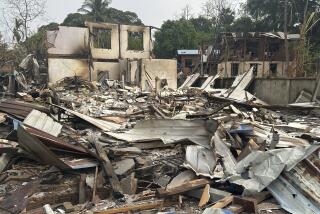British Era Fades, China Gains in Myanmar
- Share via
Waiters in starched white shirts and bow ties still serve afternoon tea and heaping platters of Yorkshire pudding at Maymyo’s Candacraig Hotel, a Tudor mansion of the defunct Bombay & Burma Trading Co.
But the British quit Burma, now Myanmar, in 1948. These days, clients at the Candacraig are likely to be a new breed of foreign fortune-seeker--Chinese businessmen exploring overseas markets.
Many of the Candacraig’s Chinese guests show up for dinner in cowboy boots, American-made blue jeans and sunglasses. Some openly carry bottles of fine Scotch whiskey.
On the streets, they’re easy to spot taking taxi rides in some of the 153 miniature horse-drawn carriages left from colonial times, when British officials used to retreat to mountaintop Maymyo to escape the heat of Mandalay.
Mandalay, now Myanmar’s second-largest city, was linked by rail to the old Burma Road, which followed an ancient trade route and was the chief supply line to China during World War II.
Here in the foothills of the Shan plateau, where the clouds rush to meet blossoming bougainvillea, the Chinese are buying turreted Victorian houses with names like “Polo Villa” and “East Ridge Estate.” And they are investing in local businesses.
Some Maymyo residents speak of darker activities.
“The Chinese have definitely replaced the British as our masters, at least in commerce,” said a Burmese businessman dressed in the traditional “longyi, “ the all-purpose wraparound garment worn by both men and women. “The Chinese underworld is laundering its money here, especially in real estate and gems.”
The Chinese presence in Maymyo, longtime residents and foreign diplomats say, is unmistakable testimony to the thriving trade--both legal and illegal--between Myanmar and its giant neighbor to the northeast.
Legal trade across the border is conservatively estimated at $1 billion a year. The boom is part of Myanmar’s efforts to open its economy after nearly three decades of state-imposed socialism and official isolation from its richer neighbors.
Meanwhile, no one here doubts that contraband Burmese timber and opium, which is turned into high-grade heroin in jungle refineries, are making traders even richer on both sides of the porous 1,370-mile border.
Myanmar produces more than 90% of the heroin in the “Golden Triangle” region, which includes neighboring Thailand and Laos. Myanmar’s forests hold more than 70% of the world’s teak reserves.
In recent years, China has become both a market and a transport route for narcotics and teak.
Policing the rugged border through thickly canopied jungle is virtually impossible, despite recent truce agreements between ethnic insurgents, including several opium warlords, and Myanmar’s hard-line military junta, the State Law and Order Restoration Council. Burmese troops hold only a narrow 37-mile-long corridor of jungle near the Chinese border town of Ruili.
Day and night, convoys of overloaded trucks and new cars make their way through Maymyo from the British-built section of the old Burma Road, which snakes across the mountains into China’s Yunnan Province.
Chinese buyers say they are shipping cheap Burmese teak, much of it cut by hill tribes in defiance of government quotas and export restrictions. They also buy gemstones, no longer a state-run monopoly, and locally grown corn.
Other Chinese appear to be watching over the delivery of Japanese cars, four-wheel drives and minibuses that move north on the Burma Road to Yunnan Province. Because most Chinese provinces levy hefty taxes, it is cheaper for Chinese businessmen to smuggle vehicles through Myanmar than to import them legally through Shanghai or Hong Kong.
“The tribes, especially the Shans, are willing to trade their culture--their forests, antiques and crafts--for the good things in life,” said Mohammed Slim, a merchant and pharmacist of Indian heritage whose family has been in Maymyo for three generations. “The Burmese and Shans want T-shirts, jeans and TVs. And the Chinese have them to sell.”
Down the same Burma Road, Myanmar’s military dictators are importing large numbers of Chinese-made light-infantry weapons and armored personnel carriers--part of a $1.4-billion arms deal signed in 1989.
Last year more than 300 trucks laden with multiple rocket launchers, recoilless rifles, mortars and ammunition passed over a new Chinese-built bridge on the Shweli River. The “gun bridge,” so-called because of the heavy volume of southbound military traffic, links China with the town of Muse and the Burma Road on the Myanmar side of the border, according to Western intelligence sources.
Chinese construction crews are reportedly improving the twisting Burma Road between the frontier Myanmar town of Lashio and the China border. Western correspondents are forbidden to travel to Lashio to see for themselves.
But Chinese goods are visibly flooding the markets of Maymyo and Mandalay. For sale are Chinese-made antibiotics and herbal medicines, Michael Jackson T-shirts, bicycles, sports shoes, beer, soft drinks, soap, toothpaste, televisions, rice cookers and other electronic appliances that are cheaper than locally made products.
“We don’t lack for anything these days, even medicines,” said John Aung Khiang, a retired Burmese army officer in Mandalay. “If you have the money, you just buy it straight away. It’s not like the old days of isolation.”
What seems undeniable, according to local Burmese and Western diplomats, is that China has dramatically shifted its strategy from supporting anti-government communist rebels within Myanmar toward greater economic cooperation with the government in Yangon (Rangoon), the capital and largest city.
As part of the increase in aid and trade deals, China has promised to build three roads linking Yunnan with Myanmar’s northernmost state, Kachin. And China is reportedly studying construction of a hydroelectric plant for Kachin state, which includes the World War II supply base of Myitkyina.
“The Burmese are just surviving,” said a Maymyo shopkeeper. “But the Chinese have won a lot of economic control and haven’t fired a shot.”
More to Read
Sign up for Essential California
The most important California stories and recommendations in your inbox every morning.
You may occasionally receive promotional content from the Los Angeles Times.










